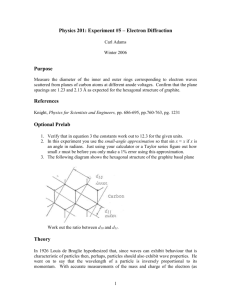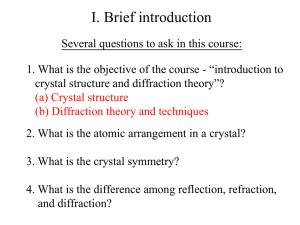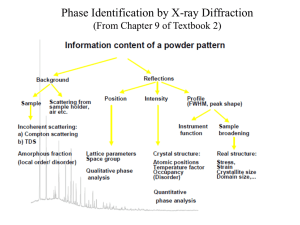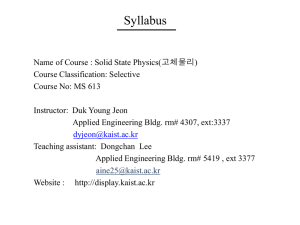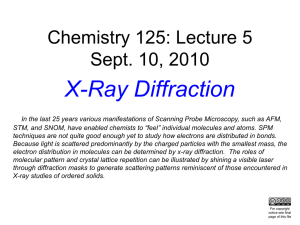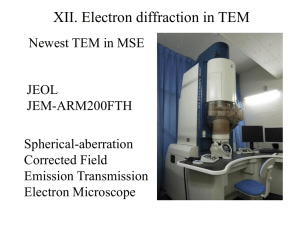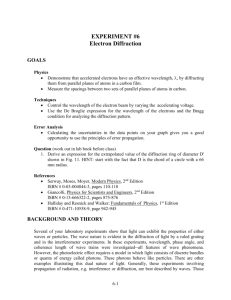Electron Diffraction
advertisement
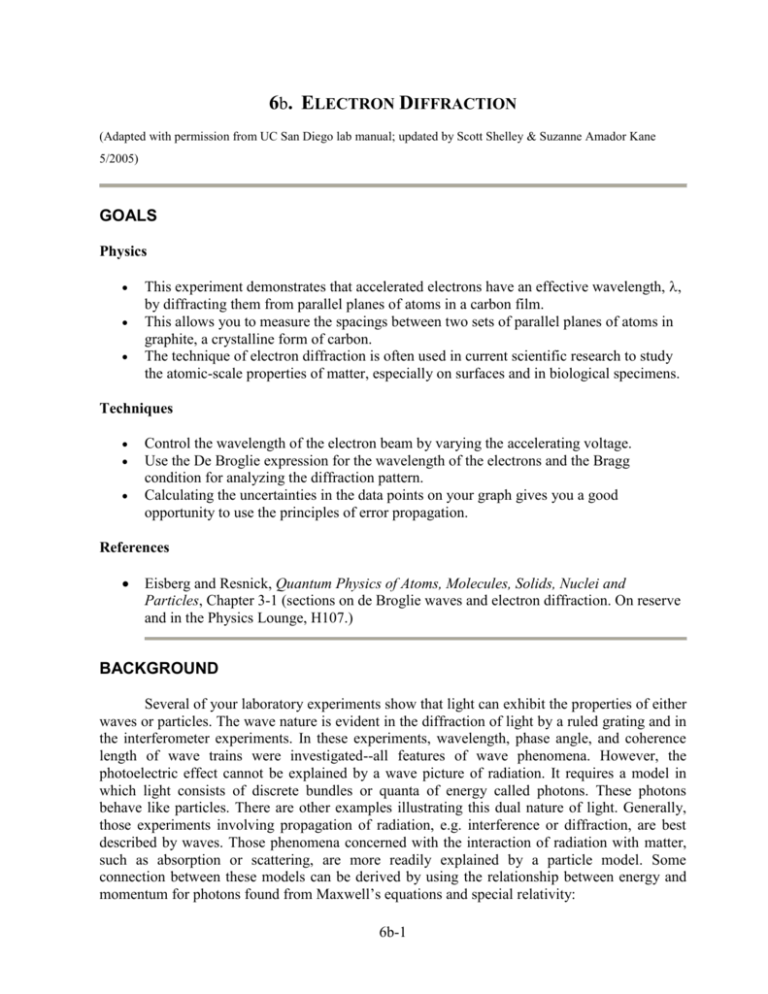
6b. ELECTRON DIFFRACTION (Adapted with permission from UC San Diego lab manual; updated by Scott Shelley & Suzanne Amador Kane 5/2005) GOALS Physics This experiment demonstrates that accelerated electrons have an effective wavelength, , by diffracting them from parallel planes of atoms in a carbon film. This allows you to measure the spacings between two sets of parallel planes of atoms in graphite, a crystalline form of carbon. The technique of electron diffraction is often used in current scientific research to study the atomic-scale properties of matter, especially on surfaces and in biological specimens. Techniques Control the wavelength of the electron beam by varying the accelerating voltage. Use the De Broglie expression for the wavelength of the electrons and the Bragg condition for analyzing the diffraction pattern. Calculating the uncertainties in the data points on your graph gives you a good opportunity to use the principles of error propagation. References Eisberg and Resnick, Quantum Physics of Atoms, Molecules, Solids, Nuclei and Particles, Chapter 3-1 (sections on de Broglie waves and electron diffraction. On reserve and in the Physics Lounge, H107.) BACKGROUND Several of your laboratory experiments show that light can exhibit the properties of either waves or particles. The wave nature is evident in the diffraction of light by a ruled grating and in the interferometer experiments. In these experiments, wavelength, phase angle, and coherence length of wave trains were investigated--all features of wave phenomena. However, the photoelectric effect cannot be explained by a wave picture of radiation. It requires a model in which light consists of discrete bundles or quanta of energy called photons. These photons behave like particles. There are other examples illustrating this dual nature of light. Generally, those experiments involving propagation of radiation, e.g. interference or diffraction, are best described by waves. Those phenomena concerned with the interaction of radiation with matter, such as absorption or scattering, are more readily explained by a particle model. Some connection between these models can be derived by using the relationship between energy and momentum for photons found from Maxwell’s equations and special relativity: 6b-1 Electron Diffraction 6b-2 E pc . Eq.1 In this equation, E is the energy of a photon, c the speed of light in vacuum and p the photon’s momentum. From the photoelectric experiment we learned that light may be considered to consist of particles called photons whose energy is E hf Eq.2 where f is the frequency of light and h is Planck's constant. We may equate these two energies and obtain: pc hf , or Eq.3a hf h c Eq.3b p where λ is the wavelength of the light. Thus the momentum of radiation may be expressed in terms of the wave characteristic λ. This dual wave-particle model of radiation led de Broglie in 1925 to suggest that since nature is likely to be symmetrical, a similar duality should exist for those entities that had previously been regarded as massive particles only. Thus, a particle such as an electron with mass m, traveling with velocity v, has a momentum p = mv. De Broglie stated that this particle could also behave as a wave and its momentum should equal the wave momentum, i.e. p mv h ; h mv Eq.4 It was now a question of verifying this hypothesis experimentally. If an electron is accelerated from rest through a potential difference V, it gains a kinetic energy 1 mv 2 eV 2 2eV v m Eq.5 where e is the electron charge and m is its mass. Substituting this value for v in the de Broglie expression for the wavelength gives h mv h 2meV 1.23 V nm where V is in Volts. Eq.6 The last formula is generally true since the constants h, m and e are fixed and known. Thus it should be fairly simple to produce a beam of electrons of a known wavelength by accelerating Electron Diffraction 6b-3 them from rest in a voltage V. This beam could then be used in experiments designed to demonstrate wave properties, e.g. interference or diffraction. One might try to diffract the beam of electrons from a grating. However, the spacings between the rulings in man-made gratings are of the order of several hundred nm. From equation (1), we find that even with an accelerating voltage as low as 100 V, the electron wavelength is only 0.12 nm. As we will see shortly, such a large difference between the grating spacing and the electron wavelength would result in an immeasurably small diffraction angle. It was recognized, however, that the spacings between atoms in a crystal were of the order of a few tenths of a nanometer. Thus, it might be feasible to use the parallel rows of atoms in a crystal as the "diffraction grating" for an electron beam. This possibility seemed particularly promising since it had been found that x-rays could be diffracted by crystals, and x-ray wavelengths are of the order of the wavelengths of 100 eV electrons. It was also known that atoms are regularly arranged in a crystal into a repeating spatial pattern called a lattice. Figure 1 shows some of the possible arrangements of atoms in a cubic lattice. (a) is the simple cubic form. When an atom is placed in the center of the simple cube, we get (b), the body-centered-cubic form. Figure 1: Three cubic arrangements of atoms in a crystal. (a) simple cubic, (b) body centeredcubic, (c) face-centered cubic When atoms are placed on the faces of the cube, as in Fig. 1 c), the arrangement is called facecentered-cubic. For example, the atoms in nickel and sodium chloride are arranged in the facecentered-cubic pattern. In an iron crystal, the body-centered-cubic arrangement is found. Figure 2 shows a view of the atoms looking perpendicular to one of the cubic faces. Three different orientations of parallel rows of atoms are distinguished with different spacings between the parallel rows. These parallel rows of atoms lie in parallel atomic planes and it is evident that there are a large number of families of parallel planes of atoms in a crystal. We will now show that waves scattered from these regularly spaced planes of atoms within crystals can act to generate constructive and destructive interference patterns similar to those generated by slits in diffraction gratings. Electron Diffraction 6b-4 Figure 2: Interplanar spacings, d, of different families of parallel planes in a cubic array of atoms. Figure 3: Scattering of waves from a plane of atoms. Path difference for waves from adjacent atoms. We consider the scattering of waves from a single plane of atoms as shown in Fig. 3. The atoms are spaced a distance d' apart. The incident wave makes an angle with a row of atoms in the surface plane waves of atoms; a c is the wavefront. The scattered wave makes an angle with the atom row; its wavefront is b e . Constructive interference will occur for the rays scattered from neighboring atoms if they are in phase; if the difference in path length is a whole number of ae cb . wavelengths. The difference in path length is Therefore a e c b d cos d cos m , where m is an integer. Another condition is that rays Electron Diffraction 6b-5 scattered from successive planes also meet in phase for constructive interference. Figure 4 shows the construction for determining this condition. Figure 4: Path difference for waves scattered from successive planes of atoms. The difference in path length for rays traveling from planes 1 and 2 is seen to be a b b c , the extra distance traveled by the ray scattered from plane 2. This path difference must again be an integral number of wavelengths. Therefore ab bc d sin d sin n . Eq. 7 These conditions can be satisfied simultaneously if . In that case m = 0 for the first condition and n 2d sin for the second condition. Eq. 8 This relation was developed by Bragg in 1912 to explain the diffraction of x-rays from crystals. n is the order of the diffraction spectrum. Thus the conditions for constructive interference are that the incident and scattered beams make equal angles and that the relation n 2d sin must be obeyed where d is the spacing between parallel adjacent planes of atoms. This is now called Bragg scattering or Bragg diffraction. Thus far, only single crystals have been considered. Most materials are polycrystalline. They are composed of a large number of small crystallites (single crystals) that are randomly oriented. An electron diffraction sample may be a polycrystalline thin film, thin enough so that the diffracted electrons can be transmitted through the film. The experimental arrangement shown in Fig. 5 was used by Thomson in 1927 to study the transmission of electrons through a thin film C. The transmitted electrons struck the photographic plate P as shown. The pattern recorded on the film was a series of concentric rings. This pattern arises from the polycrystalline nature of the film. Electron Diffraction 6b-6 Figure 5: The experimental arrangement used by Thomson for his transmission electron diffraction research. Figure 6(a) shows a beam of electrons of wavelength traveling from the left and striking a plane of atoms in a crystallite. If this plane makes the angle with the incident beam such that 2d sin , where d is the spacing of successive atomic planes, the beam will be diffracted into the angle with respect to the atom plane (or the angle 2 that the diffracted beam makes with the incident beam). Figure 6: Showing how the randomly oriented crystallites in a polycrystalline film scatter into a cone when the Bragg condition is fulfilled by planes of atoms disposed symmetrically about the incident beam. Now there are many randomly oriented crystallites in this film. Thus we may expect that there will be crystallites in which this diffracting plane makes the same angle with the beam direction but rotated around the beam in a cone as shown in Fig. 9(b). The diffracted beams from this plane from all the crystallites in the sample will fall on a circle whose diameter may be determined from the cone angle 2 and the distance from the sample to the film or other Electron Diffraction 6b-7 detector and the Bragg condition. In 1927 the wave nature of electrons was verified by reflection and transmission diffraction experiments. For this work Germer and Thomson were awarded the Nobel Prize in 1937. De Broglie received the Nobel Prize in 1929 for his basic insight on the wave nature of matter. More about Crystal Lattices We explained above that crystal lattices are the orderly, symmetrical microscopic arrangement of atoms one finds in many materials, such as metals, minerals and ceramics. Our brief treatment above glossed over some important refinements, however. The mathematical description of lattices consists of a specification of a minimum set of atoms (the “unit cell”) which can be used to generate the entire lattice when they are copied, then moved to a new location along a set of vectors with specific lengths and directions. These vectors are called “lattice vectors” because you reproduce the entire lattice by taking the unit cell and copying it, then moving the copy an integral number of lattice vectors. This is exactly like tiling the floor of a kitchen by using one standard tile (with a pattern) and placing copies of this tile in a regular arrangement. The smallest tile that can be used to reproduce the pattern in this way is analogous to the unit cell. For a substance such as sodium chloride, the unit cell consists of one sodium atom and one chlorine atom (Fig. 7). Figure 7: Cubic lattice similar to that found for sodium-chloride (NaCl) or table salt. The different colored spheres correspond to the two atomic species. The entire lattice can be generated by moving the unit cell (one Na plus one Cl) along the three orthogonal axes of the cubic array. N. Ashcroft and D. Mermin, Solid State Physics. Brooks Cole, 1976. In your electron diffraction experiment, you will look at the diffraction of electrons from graphite, a crystalline form of carbon found in pencil “lead” and used as a dry lubricant. (Carbon can take on many other structures, including diamond, fullerenes and nanotubes.) Graphite forms crystals in which the carbons are arranged into stacks of flat layers, called graphene planes, shown in Fig. 8. The hexagonal honeycomb lattice within each plane in graphite looks like it has a lattice structure, and indeed so it does. However, you need to exercise some care in defining the unit cell of graphite. You might assume naively that you could just take one of the atoms of carbon, and then move it about to generate the entire lattice. That’s what worked above for the cubic lattice in Fig.1. However, if you try to take any one of the atoms in the graphite Electron Diffraction 6b-8 structure shown in Fig. 8 and move it one carbon-carbon bond length over, you may get a correct lattice position, or you may get a position that does not correspond to the actual honeycomb lattice, but instead the empty center of the hexagons. To think about the honeycomb graphite lattice properly, you need to consider a unit cell that consists of TWO carbon atoms at a time, as shown in Fig. 8 by the two atoms connected by a solid line. The lattice vectors are shown on the righthand image. Prelab Question 1: Satisfy yourself that if you take the two-atom unit cell indicated, you can generate the entire lattice by moving it along integer multiples of the lattice vectors. Figure 8: Honeycomb lattice found within the layers of graphite. All nearest-neighbor carbon atoms (black circles) within the plane are connected by equivalent chemical bonding, with a charcter intermediate between single and double bonds. Lefthand image: the lattice, showing the unit cells (two atoms connected by a solid line). Righthand image: Honeycomb lattice, showing the unit vectors needed to generate the lattice, using the unit cell indicated at left. . N. Ashcroft and D. Mermin, Solid State Physics. Brooks Cole, 1976. All this is relevant to your electron diffraction experiment (or any diffraction experiment with x-rays, neutrons, etc.) because the lattice vectors and unit cells determine which atomic planes are involved in Bragg diffraction. Only atomic planes separating adjacent unit cells will generate Bragg diffraction, because only those planes repeat exactly throughout the lattice. This is shown in Fig. 9(a) for graphite. The relevant d spacings are 0.123 nm and 0.213 nm. (Fig. 9(b) shows the distance between the stacked graphene planes. These are arranged so as to give Bragg diffraction with a distance d = 0.688 nm.) An easy way to see which planes will give Bragg diffraction is to replace the (confusing) honeycomb lattice with the simpler underlying lattice composed of the locations of the pairs of atoms. Any planes drawn through this lattice will result in Bragg diffraction. Prelab Question 2: Draw the lattice formed by replacing the two-atom unit cell in Fig. 8 by a single circle, and prove to yourself that the planes involving this new, simpler lattice have the spacings shown in Fig. 9. Electron Diffraction 6b-9 (a) (b) Figure 9: (a) Atom arrangements in graphite showing the two sets of planes within the graphene layers that produce the diffraction rings you observe in your experiment. These spacings are 0.123 nm and 0.213 nm. (b) The graphene planes are stacked as shown to form the 3D lattice. Note that the two layers adjacent to each other have inequivalent atomic arrangements. This means that the effective lattice spacing for diffraction between layers is 688 pm (picometers), as shown. http://phya.yonsei.ac.kr/~phylab/board/exp_ref/upfile/phywe/5_1_13.pdf Experimental Procedure Equipment 1. Electron diffraction tube with graphite thin film target. 2. Power supply that provides the current to heat the anode and the high voltage for accelerating the electrons. 3. Calipers for measuring diffraction ring diameters. CAUTION The 5kV power source can give you a very nasty shock. Verify that your circuit is correctly wired before turning on power. Have your instructor check the circuit. Electron Diffraction 6b-10 Figure 10: The electron diffraction tube The electron diffraction tube is sketched in Fig. 10. The graphite film is mounted in the anode as shown. The variable accelerating voltage is provided by the 5kV dc supply. The electrons are emitted from an indirectly heated oxide coated cathode. They boil off this cathode filament wires with a small thermal energy which is negligible compared to the kilo eV provided by the accelerating voltage. The heater voltage is supplied by the same power supply as provides the accelerating voltage. This power supply also supplies a negative voltage to the metal can surrounding the cathode that emits the electrons. This serves to focus the electron beam. The diffraction rings are viewed on the phosphor screen on the glass bulb. The apparatus should be connected up. If not have your instructors do so. The connections are: F3 & F4 = filament voltage (orientation not important); A1 not connected; G7 Anode (red High Voltage connector); C5 Cathode (black High Voltage connector). After having your circuit checked, start the experiment by allowing the heater current to stabilize for about a minute before turning up the accelerating voltage, on the front panel of the power supply. You can also read off the high voltage, V, from the front panel display. You will see rings on the phosphor screen for selected values of the accelerating voltage, but you will need to darken the room before doing so. As discussed above, Fig. 9 shows the arrangement of the atoms in a graphite crystal. They are located on the corners of a hexagon and two principal spacings of the atom planes are indicated as d1 and d2. As you turn up the accelerating voltage, you will see two rings on the screen, as shown in Fig. 11 below. Each ring corresponds to one of the graphite d spacings from Fig. 9(a). Slowly turn up the accelerating high voltage while carefully viewing the phosphor screen to get a feeling for which voltage values allow you to see one and two rings. Try this now, varying your accelerating high voltage and observing how the ring diameters on the screen, D, (and hence the diffraction angles) vary with voltage. Note how wide a distribution of D values corresponds to a typical ring—what do you think causes this ring width? Record your observations and explain in your report how they make sense, given the relationship between electron energy, de Broglie wavelength and scattering angle. You will want to make a careful assessment of how many values of accelerating voltage to make measurements at. Clearly you cannot take 100 distinct measurements of ring diameter, but you Electron Diffraction 6b-11 should not be satisfied by just a few either. Make a rational choice of how many different accelerating voltages to use for each distinct Bragg diffraction ring, and explain your reasoning. Once you are done, record your data for the two different layer spacings (ring 1 and ring 2) as a function of ring diameter, D, vs. voltage, V. This is your basic dataset you will now analyze to determine the graphite layer spacings. Note that in our earlier discussion and in Fig. 11, we define the angle between the direction of the undiffracted electron beam and the diffracted ring as 2 . This convention is common in the diffraction and crystallography literature, but it can be confusing. Be sure to note this factor of two in case you wind up with a missing factor of two in your derivations! Figure 11: Sketch of the geometry involved in determining scattering angle, 2q, from the measured ring diameter, D. (Note that the 66.0 mm is supposed to be the radius of the spherical glass electron diffraction bulb. D is the diameter of the ring you measure on the glass electron diffraction apparatus, while D’ is the diameter of the larger ring you would get by extrapolating the path of the electron’s past the bulb onto a flat screen tangential to the front of the bulb.) As explained above, the Bragg diffraction condition for the polycrystalline graphite film is 2d sin , Eq. 9 Measure the ring diameter D on the screen with the calipers, along with its experimental uncertainty. (If you are unsure about how to use Vernier calipers, consult Appendix B and/or ask your instructor.) To determine sin , you must calculate the relationship between measured ring diameter D and the scattering angle, , as shown in Fig. 11. You can do this in two ways. You can either: 1) directly compute angle, , from D (probably easiest) or 2) you can compute the extrapolated diameter, D’, from D first, then use the value for D' to calculate : tan D 4L Eq. 10 Electron Diffraction 6b-12 where both D’ and L are in the same units, and is in radians. Be sure to correct for the thickness of the glass sphere, as shown in Fig. 11. Prelab Question 3: Derive the relationship between measured D and sin , resulting in the functional relationship sin (D). Using the drawing above, confirm that your relationship works for the actual values of D, L, etc. used. Then, you can combine your knowledge of with the relationship between electron de Broglie wavelength (in nm) from Eq. 9 with the energy accelerating voltage, V (in Volts) from Eq. 6, to compute your measured values of d: Prelab Question 4: Derive the relationship between your measured data for (via the measured D), and V, being careful about units. To analyze your data, for each ring, plot 1 V as a function of sin for a number of values of V. Determine d1 and d2 from the slopes of these curves. Using uncertainty analysis, compare your values to the d spacings given above for graphite. To compute error bars in 1 V and sin it is easiest to use the trick suggested in the excerpts from Practical Physics by Squires. When you have a very complicated function (such as the dependence of angle on D’), it’s easier to just compute the range of variation in the complicated function (here sin (D)) directly, rather than computing its derivatives. (That is, just compute how changing D from D to D+ D affects , rather than trying to compute d (sin)/dD, then using that to compute d(sin).) Similarly, you can just compute the variation in 1 V directly by using the measured range of variation in V. To produce a plot in Origin with associated error bars, do the following. You can use the error bar feature in Origin to plot error bars on your graph here. Create columns in Origin for your data and their associated error bars. Right click on each column and choose its Properties. Under Plot Designation, choose X for the x-values, Y for y, Xerr for the x error bars, and Yerr for the y error bars. Now, when you plot your data as a scatter plot, it will show up with error bars. You can either use the fitting features in Origin or just a ruler to see how the error bars affect your estimates of the fitted slope and intercepts.) Lab Report 1. Be sure to turn off your high voltage supply before you leave the lab, but leave all electrical leads connected. 2. Make sure you have estimated (and checked the accuracy) of your ring diameter, D, to scattering angle, , conversions BEFORE leaving lab! 3. Record answers to all prelab questions in your lab report. 4. Record all requested observations and measurements as indicated in the lab manual in your report. Electron Diffraction 6b-13 5. Record all experimental uncertainties before you leave the lab. Detail in your lab report what the major sources of uncertainty are, and include error bars for all of your estimated layer spacings. If your results for the d values are far off of our estimated values, consult with an instructor within or outside of lab. 6. Explain why you cannot see the diffracted ring due to diffraction between stacked graphene layers (as opposed to the diffraction due to layers within the graphene planes.)

